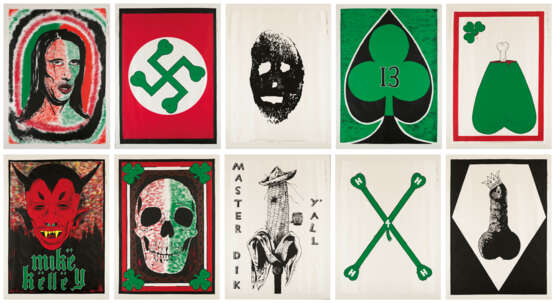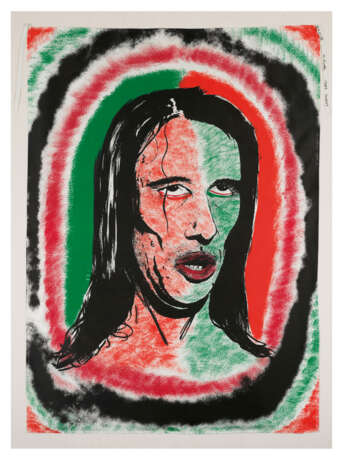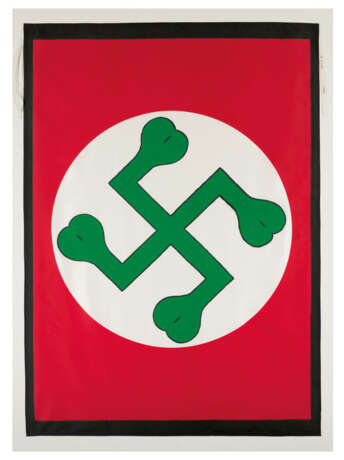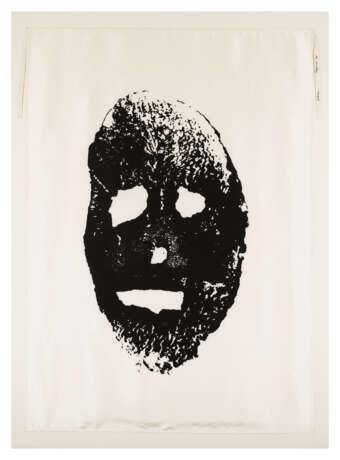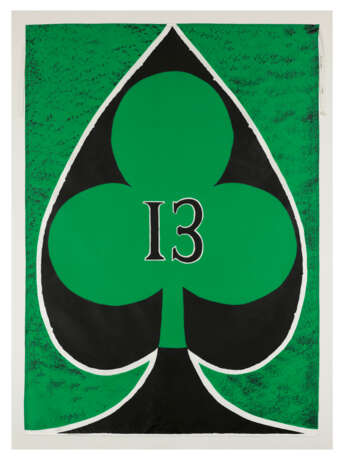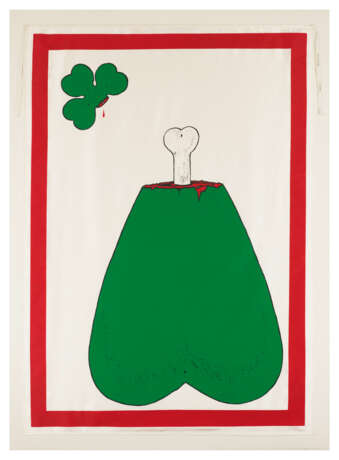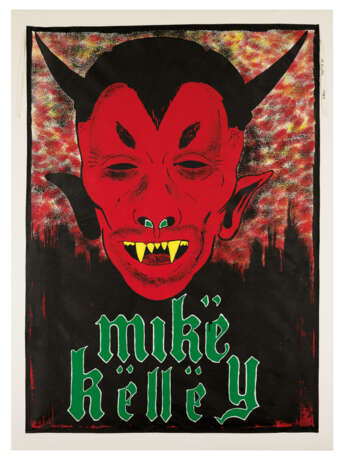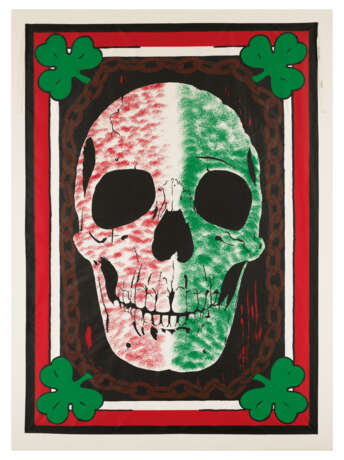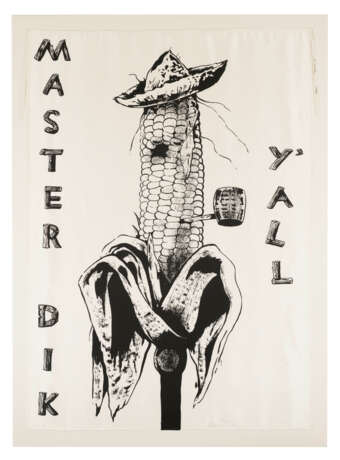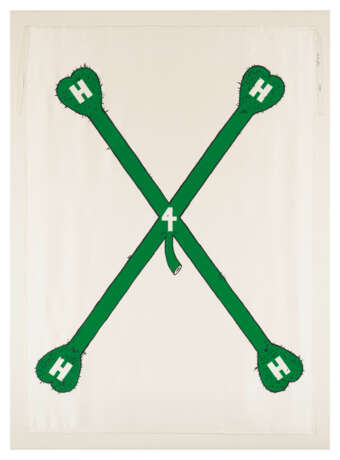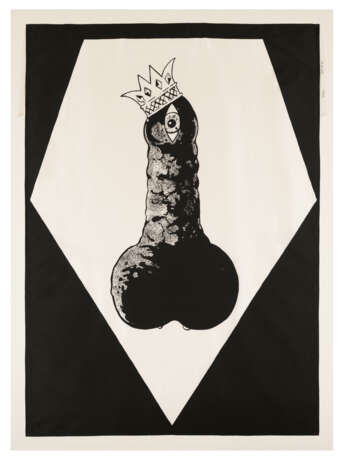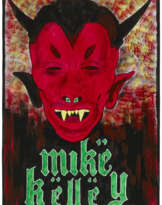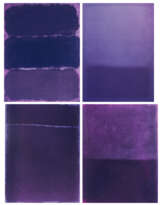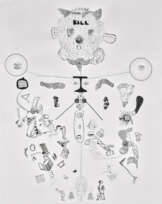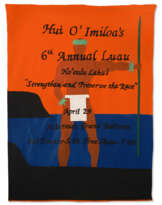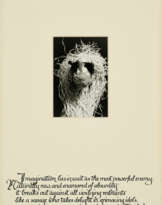ID 813856
Lot 62 | Mike Kelley (1954-2012)
Estimate value
€ 25 000 – 35 000
Pansy Metal / Clovered Hoof
chaque : signée, datée et numérotée 'M. Kelley 1989 1/40' (sur un ruban de coton en haut à droite)
la planche intitulée The Orange and Green : numérotée 'AP I/X'
ensemble de dix sérigraphies en couleurs sur soie Habotai, fixées par des agraffes sur un support cartonné toilé
chaque: 134 x 95.7 cm.
Réalisée en 1989, cette série est numérotée 1/40 et AP I/X pour la planche intitulée The Orange and Green, publiée par Julie Sylvester Cabot, New York.
each: signed, dated and numbered 'M. Kelley 1989 1/40' (on a fabric strip upper right)
the plate titled The Orange and Green: numbered 'AP I/X'
set of ten silkscreen on Habotai silk, fixed with staples on a carboard with canvas
each: 52 6⁄8 x 3.7 5/8 in.
Executed in 1989, this set is number one of an and AP I/X for the plate titled The Orange and Green, published by Julie Sylvester Cabot, New York.
Provenance
Galerie Ghislaine Hussenot, Paris
Acquis auprès de celle-ci en 2006
Special notice
This item will be transferred to an offsite warehouse after the sale. Please refer to department for information about storage charges and collection
details.
Post lot text
« Là où l'art est une sorte d'idée intéressante, là où le dysfonctionnement est autorisé ». - Mike Kelley.
"Where art is some sort of interesting idea, where dysfunction is allowed." - Mike Kelley
Figure parmi les plus importantes de la scène artistique américaine de ces cinquante dernières années, Mike Kelley est un personnage irrévérencieux et complexe, pétri de culture philosophique comme de références à la contre-culture punk rock. Son travail se déploie dans un éventail singulier de genres et de styles qui vont de l’illustration à la peinture, en passant par le dessin, la photographie, la vidéo, la musique et la performance. C’est d’ailleurs par la performance qu’il initie sa trajectoire d’artiste à la fin des années 1970 ; avant que ses peintures revendicatrices, textes et installations des années 1980, mettant à mal les hiérarchies artistiques établies et questionnant les fondements de l’identité culturelle américaine, lui valent une vaste reconnaissance internationale.
L’œuvre présente dans la collection du Comte et de la Comtesse Jean-Jacques de Flers s’inscrit au cœur de l’enquête que mène l’artiste autour de la mémoire, des traumatismes et de la répression. S’emparant de symboles forts et volontiers violents de la culture vernaculaire, Kelley donne à voir ici ce qui constitue l’un des ressorts principaux de sa pratique artistique : ébranler les soubassements de la construction identitaire collective, détourner des concepts psychologiques, philosophiques et artistiques à travers des scénarios décalés et des supports rudimentaires. Ce faisant, Kelley casse les codes de l’histoire de l’art et impose une vision de la création à la fois ironique et subversive. Dans un mélange unique de scepticisme et de dérision, l’artiste joue sur les langages et les présupposés de l'éducation, de l'adolescence, de l'artisanat et du bricolage, des vacances, de la psychologie populaire, des rituels, des reportages de journaux et des modes.
Décédé en 2012, Mike Kelley laisse derrière lui une œuvre riche et complexe, avec un corpus d’écrits critiques et créatifs ainsi que des peintures, dessins et sculptures. Ses œuvres sont aujourd’hui conservées dans les collections de nombreuses institutions internationales et ont notamment fait l’objet d’expositions au Stedelijk Museumd d’Amsterdam (2012), au Louvre (2006), à la Tate Liverpool (2004), au Museum of Contemporary Art de Detroit (2013), au Centre Pompidou (2013) ou encore du MoMA à New York et au Museum of Contemporary Art à Los Angeles en 2013-2014.
One of the most important figures on the American art scene of the last fifty years, Mike Kelley is an irreverent and complex character, steeped in philosophical culture as well as references to the punk rock counterculture. His work spans a singular range of genres and styles, from illustration and painting to drawing, photography, video, music and performance. It was through performance art that he began his career as an artist in the late 1970s, before his protest paintings, texts and installations of the 1980s, which challenged established artistic hierarchies and questioned the foundations of American cultural identity—earning him widespread international recognition.
The work in the Count and Countess Jean-Jacques de Flers collection is at the heart of the artist's investigation into memory, trauma and repression. Seizing on strong and often violent symbols of vernacular culture, Kelley displays here what constitutes one of the main springs of his artistic practice: shaking the foundations of the collective construction of identity, diverting psychological, philosophical and artistic concepts through shifted scenarios and rudimentary supports. In doing so, Kelley breaks the codes of art history and imposes a vision of creation that is both ironic and subversive. In a unique blend of scepticism and derision, the artist plays with the languages and assumptions of education, adolescence, craft and DIY, holidays, popular psychology, rituals, newspaper coverage and fashion.
Mike Kelley, who died in 2012, leaves behind a rich and complex body of work, including a wide array of critical and creative writing as well as paintings, drawings and sculptures. His work is now held in the collections of many international institutions, including exhibitions at the Stedelijk Museum in Amsterdam (2012), the Louvre (2006), the Tate Liverpool (2004), the Museum of Contemporary Art in Detroit (2013), the Centre Pompidou (2013), and MoMA in New York, as well as the Museum of Contemporary Art in Los Angeles in 2013-2014.
| Artist: | Mike Kelley (1954 - 2012) |
|---|---|
| Art style: | Contemporary art |
| Artist: | Mike Kelley (1954 - 2012) |
|---|---|
| Art style: | Contemporary art |
| Address of auction |
CHRISTIE'S 9 Avenue Matignon 75008 Paris France | ||||||||||||||
|---|---|---|---|---|---|---|---|---|---|---|---|---|---|---|---|
| Preview |
| ||||||||||||||
| Phone | +33 (0)1 40 76 85 85 | ||||||||||||||
| Fax | +33 (0)1 40 76 85 86 | ||||||||||||||
| Conditions of purchase | Conditions of purchase | ||||||||||||||
| Shipping |
Postal service Courier service pickup by yourself | ||||||||||||||
| Payment methods |
Wire Transfer | ||||||||||||||
| Business hours | Business hours
|
